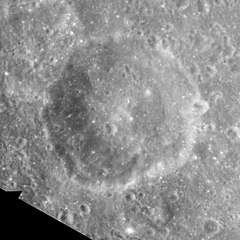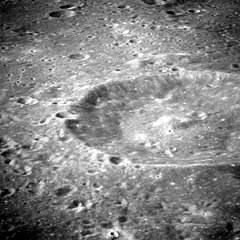Kapteyn (crater)
Kapetyn is a lunar impact crater that is near the eastern limb of the Moon, to the west of the crater La Pérouse. West of Kapetyn is the slightly smaller Barkla, and farther to the west-northwest is the prominent Langrenus. Von Behring is to the north-northeast.
 Apollo 15 Mapping Camera image | |
| Coordinates | 10.8°S 70.6°E |
|---|---|
| Diameter | 49 km |
| Depth | Unknown |
| Colongitude | 290° at sunrise |
| Eponym | Jacobus C. Kapteyn |

Oblique view from Apollo 8, facing south
This crater is circular in shape, although it appears oval when viewed from the Earth due to foreshortening. The rim is only slightly worn, with no craters of note along the edge or the inner walls. There is a shelf along the eastern inner wall. At the midpoint of the interior floor is a central peak.
Satellite craters
By convention these features are identified on lunar maps by placing the letter on the side of the crater midpoint that is closest to Kapteyn.
| Kapteyn | Latitude | Longitude | Diameter |
|---|---|---|---|
| A | 14.2° S | 71.3° E | 31 km |
| B | 15.6° S | 71.0° E | 39 km |
| C | 13.3° S | 70.2° E | 48 km |
| D | 14.5° S | 70.6° E | 12 km |
| E | 8.8° S | 69.3° E | 31 km |
| F | 14.5° S | 70.3° E | 9 km |
| K | 13.1° S | 71.9° E | 8 km |
| Z | 11.2° S | 72.5° E | 6 km |
gollark: Which is?
gollark: <@237328509234708481> Nobody ever actually uses the cd thing for more than a few commands.
gollark: I think.
gollark: `shell=_G.shell`
gollark: I edited it a bit, and now it works reasonably fast, as long as you don't use edit. Why? Because edit results in stupidly large batches of a few hundred term calls being sent down the socket, which crashes the receiver, usually.
References
- Andersson, L. E.; Whitaker, E. A. (1982). NASA Catalogue of Lunar Nomenclature. NASA RP-1097.CS1 maint: ref=harv (link)
- Blue, Jennifer (July 25, 2007). "Gazetteer of Planetary Nomenclature". USGS. Retrieved 2007-08-05.CS1 maint: ref=harv (link)
- Bussey, B.; Spudis, P. (2004). The Clementine Atlas of the Moon. New York: Cambridge University Press. ISBN 978-0-521-81528-4.CS1 maint: ref=harv (link)
- Cocks, Elijah E.; Cocks, Josiah C. (1995). Who's Who on the Moon: A Biographical Dictionary of Lunar Nomenclature. Tudor Publishers. ISBN 978-0-936389-27-1.CS1 maint: ref=harv (link)
- McDowell, Jonathan (July 15, 2007). "Lunar Nomenclature". Jonathan's Space Report. Retrieved 2007-10-24.CS1 maint: ref=harv (link)
- Menzel, D. H.; Minnaert, M.; Levin, B.; Dollfus, A.; Bell, B. (1971). "Report on Lunar Nomenclature by the Working Group of Commission 17 of the IAU". Space Science Reviews. 12 (2): 136–186. Bibcode:1971SSRv...12..136M. doi:10.1007/BF00171763.CS1 maint: ref=harv (link)
- Moore, Patrick (2001). On the Moon. Sterling Publishing Co. ISBN 978-0-304-35469-6.CS1 maint: ref=harv (link)
- Price, Fred W. (1988). The Moon Observer's Handbook. Cambridge University Press. ISBN 978-0-521-33500-3.CS1 maint: ref=harv (link)
- Rükl, Antonín (1990). Atlas of the Moon. Kalmbach Books. ISBN 978-0-913135-17-4.CS1 maint: ref=harv (link)
- Webb, Rev. T. W. (1962). Celestial Objects for Common Telescopes (6th revised ed.). Dover. ISBN 978-0-486-20917-3.CS1 maint: ref=harv (link)
- Whitaker, Ewen A. (1999). Mapping and Naming the Moon. Cambridge University Press. ISBN 978-0-521-62248-6.CS1 maint: ref=harv (link)
- Wlasuk, Peter T. (2000). Observing the Moon. Springer. ISBN 978-1-85233-193-1.CS1 maint: ref=harv (link)
This article is issued from Wikipedia. The text is licensed under Creative Commons - Attribution - Sharealike. Additional terms may apply for the media files.